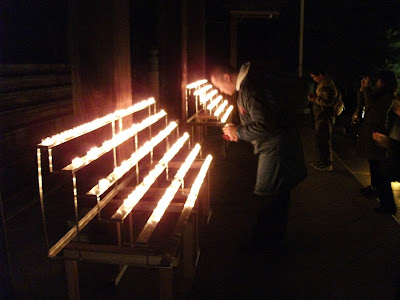Time for my final ICT travel post, a quick trip to the unique city of Nagasaki just before Christmas. Please enjoy the photos and captions below. But this will not be the end of this blog! I am now in Okinawa serving a Fleet Marine Force assignment. While I will not post specifics of my professional life here, I will still be getting out into the Okinawan culture and will capture observations as the opportunities arise, and share them as time permits. Thank you for your attention to this blog this past year, it has truly been rewarding for me. Semper fi!
And now, Nagasaki...
And now, Nagasaki...
 |
| One of the entrances to the city's Chinatown district, a big tourist draw but quite small and elegant compared to any of the cities I visited in China. |
 |
| The Koban, or "Police Box" neighborhood police office found everywhere in Japan takes a distinctly European flavor in the quarter where I spent a night. |
 |
| The Catholic church which I believe is the oldest one in Nagasaki, which remains active but is also a museum. |
 |
| The inside of the church with its many elegant if simple stained glass windows which have become popular designs for tourism gifts. |
 |
| A picture of Nagasaki Bay with an old steam and sail ship at anchor, supposedly a museum but not open at the time of my visit. |
 |
| Nagasaki's religious influences today sit side by side throughout the city. Just a short walk from the 26 Martyrs site is this impressive Buddha temple with its turtle-shaped roof. |
 |
| Of course, Nagasaki is commonly popular for being the second city to be atomically bombed, and its A-Bomb museum is an important element to the city. |
 |
| An interesting timeline presented in the museum. Both Nagasaki and Hiroshima appear to have made the decision long ago to present the history of WWII without much emphasis on the actions of Japan leading up to America's involvement in the Pacific. |
 |
| Despite its less than comprehensive criticism of WWII's inception and conduct, Nagasaki's A-Bomb museum does an admirable job of championing the cause of global nuclear disarmament. |
 |
| Towards the promoting of a nuke-free world, no museum can offer as powerful a message as this monument of the hypocenter can, where 500 meters above the bomb was detonated. |



































